



We ran a feeding trial to determine optimal dietary protein and lipid levels for growth of juvenile long snout bullhead
어류가 활동하고 성장하기 위해서는 수십 가지의 필수 영양소와 에너지가 필요한데, 이 중에서도 단백질은 어류의 성장에 가장 큰 영향을 미치는 필수 영양소이다. 또한, 사료의 영양 성분 중 단백질 함량이 차지하는 비율이 매우 높고, 사료에 배합되는 단백질원의 가격이 비싸기 때문에, 양식 대상어종의 적정 사료 단백질 함량을 구명하는 것은 경제적인 배합사료 개발에 필수적이다. 단백질뿐 아니라 비단백질 유래의 에너지 함량도 양어 사료 설계시 매우 중요한 역할을 담당하고 있다. 즉, 사료의 에너지 함량이 낮으면 어체 내에서 단백질을 분해하여 에너지원으로 사용하기 때문에 단백질효율이 낮아지고, 사료 중에 단백질원이 차지하는 단가가 높기 때문에 그 만큼 양식 생산비용이 높아지게 된다. 반대로 사료의 에너지가 높으면, 사료 섭취량이 줄어들어 최적 성장에 필요한 필수영양소의 섭취가 상대적으로 줄어들어 성장이 저해되고 어체에 지방 축적이 높아져 품질이 저하된다(NRC, 2011). 이와 같이 사료의 단백질에 대한 에너지의 함량이나 비율이 맞지 않으면, 양식어류 생산에 소요되는 사료 단가가 상승할 뿐 아니라 사료유래의 수질오염원이 증가될 수 있기 때문에 사료의 적정 단백질과 에너지 함량에 관한 연구는 매우 중요하다(Hillestad et al., 2001). 사료의 에너지 함량은 지질이나 탄수화물 함량을 달리 첨가하여 조절하는데, 어류의 식성, 사료 성형 등을 고려하여 배합사료의 원료들을 선정하여 조성한다. 사료 단백질을 절약할 수 있는 방안은 섭취된 사료의 단백질이 어류의 성장에 효율적으로 사용될 수 있도록 사료의 비 단백질 유래의 에너지 함량을 적절히 사료에 배합하는 것이다(NRC, 2011). 즉, 어류가 섭취한 사료의 비 단백질 에너지원으로 지질이나 탄수화물을 최대로 이용할 수 있도록 하는 사료 영양소 조성표를 제시하는 것이다. 이러한 비 단백질 에너지원의 이용은 어류의 식성 등에 따라서 달라지는데, 일반적으로 육식성이나 잡식성 어류들이 초식성 어류들보다 지질 이용성 높고, 초식성이 강한 어류는 육식성이나 잡식성 어류보다 탄수화물 이용성이 높은 것으로 알려져 있다.
종어(
실험사료의 원료조성과 영양소 분석 결과를 Table 1에 나타내었다. 4×2 factorial 디자인으로 4종류의 단백질 함량(20%, 30%, 40% 및 50%)과 2종류의 지질 함량(7% 및 14%)을 함유하고 있는 총 8종류의 실험사료를 제조하였다. 실험사료의 단백질원으로 어분을 사용하였고, 지질원으로 어유, 대두유 및 아마인유를 각각 사용하였다. 탄수화물원으로 소맥분을 사용하였고, 사료의 단백질과 지질 함량은 이 원료들의 첨가 비로 조절하였다. 이와 같이 설계된 원료들을 잘 혼합한 후 원료 100 g당 물 30 g을 첨가하여 moist pellet 제조기로 압출 성형한 후, 실온에서 건조시켜 -30℃에 냉동 보관하면서 사용하였다. 실험사료의 지방산 조성은 Table 2에 나타내었다.
[Table 1.] Ingredient and proximate composition of experimental diets
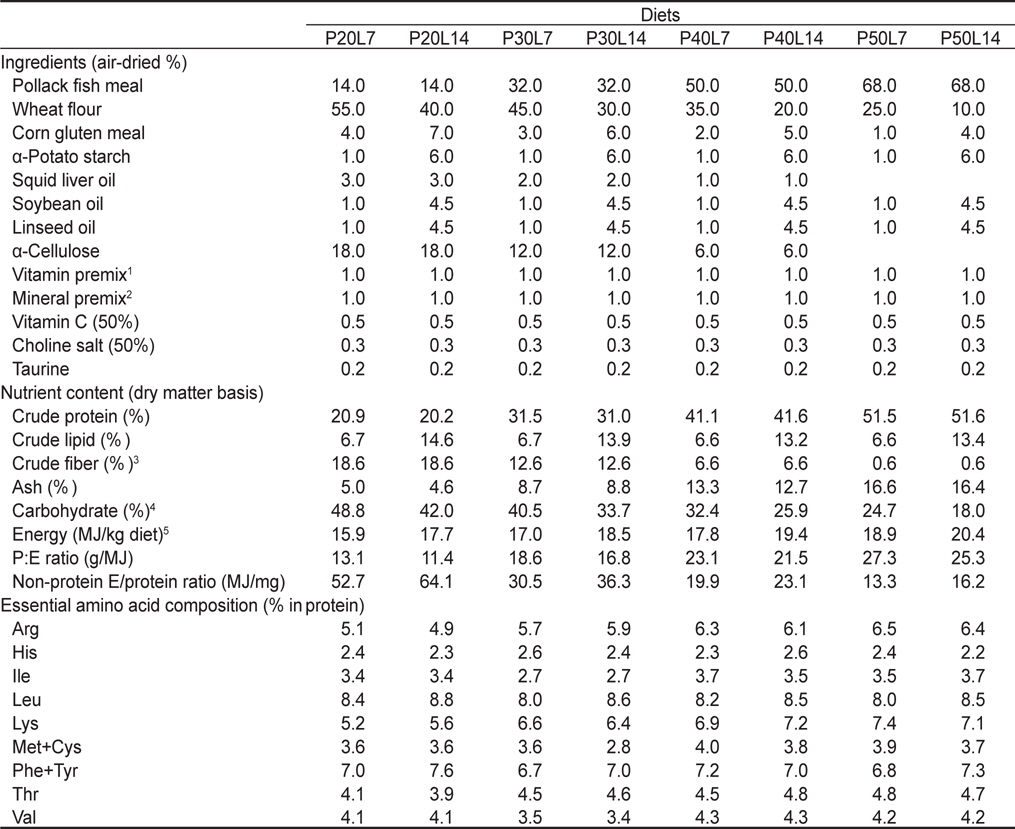
Ingredient and proximate composition of experimental diets
[Table 2.] Major fatty acid composition (% of the total fatty acids) of the experimental diets
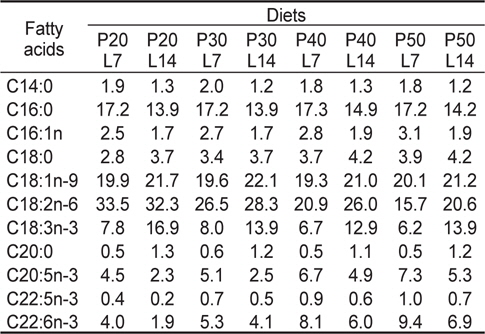
Major fatty acid composition (% of the total fatty acids) of the experimental diets
실험어는 국립수산과학원 내수면양식연구소에서 종묘 생산된 종어 치어를 사용하였다. 실험어는 2주간 실험수조에 순치시킨 후, 외형적으로 건강한 평균체중 3.9±0.20 g의 종어 치어를 선별하여 총 24개의 400 L 수조에 각각 20마리씩 3반복으로 수용하여 8주간 사육 실험하였다. 사육수는 지하수를 사용하였으며, 사육기간 동안 수온은 24.1±0.82˚C였고, 각 수조마다 약하게 폭기시켜 산소를 공급하였다. 실험사료는 1일 2회(9:00, 17:00) 실험어가 먹을 때까지 손으로 만복 공급하였다. 사육기간 중 죽은 개체는 매일 제거하였으며, 하루에 한번(13:00) 수조 청소를 실시하고, 일일 사료 섭취량과 폐사어 등은 매일 기록하였다.
어체 측정은 사육실험 시작시와 종료시에 측정 전일 절식시킨 후 tricaine methanesulfonate (MS 222, Sigma, St. Louis, MO, USA) 100 ppm 수용액에 마취시켜 수조에 수용된 실험어의 무게를 측정하였다. 사육 종료시에 혈액성분의 변화를 조사하기 위해 헤파린이 처리된 1 mL 주사기를 사용하여 실험어의 미부 혈관에서 채혈하였으며, 채혈한 혈액은 7,500×g에서 10분간 원심 분리하여 얻은 혈청을 동결보존(-70˚C)하였다. 혈액분석은 임상용 kit (Asan pharmaceutical Co., Seoul, Korea)를 사용하여 total protein은 burette법으로 glucose는 효소법으로, cholesterol은 COD-POD법을 사용하여 각각 분석하였다. 실험사료 및 어체의 일반성분은 AOAC (1995) 방법에 따라, 조단백질(N×6.25)은 Auto Kjeldahl system (Buchi B-324/435/412, Switzerland; Metrohm 8-719/806, Swizerland)을 사용하여 분석하였고, 조지방은 ether로 추출하여 측정하였으며, 수분은 105˚C dry oven에서 6시간 동안 건조 후 측정하였고, 회분은 600˚C 회화로에서 4시간 동안 태운 후 측정하였다. 지방산 분석은 Folch et al. (1957)의 방법에 따라 총 지질을 추출하여 14% BF3-methanol (Sigma, USA) 용액으로 지방산을 methylation 시킨 후, capillary column (SP™-2560, 100 m × 0.25 mm i. d., film thickness 0.20 μm, USA)이 장착된 gas chromatography (Perkin Elmer, Clarus 600, USA)로 지방산을 분석하였다. Carrier gas는 헬륨을 사용하였으며, oven 온도는 최초 140˚C에서 240˚C까지 4˚C/min 증가시켰다. 이때, injector 온도는 240˚C, detector (FID) 온도는 240˚C로 각각 설정하였으며, 표준 지방산으로 37개 지방산 혼합물(PUFA 37 Component FAME Mix, USA)을 사용하였다. 아미노산은 시료를 6 N HCl로 110˚C sand bath 상에서 24시간 가수분해한 후, 감압 농축하고, Automatic amino acid analyzer (L-8800, Hitachi, Column : Ion exchange, Injection Pump : Pressure 0-19.6Mpa, Flow Rate 0.05-0.99 mL/min, Column Oven : Electrothermal cooling (30-70˚C), Reaction Unit : Reaction Column (135˚C, 50˚C), Photometer : Wavelength 570 nm, 440 nm)를 사용하여 분석하였다.
결과의 통계처리는 SPSS Version 20.0 (SPSS Inc., Chicago, IL, USA) program을 사용하여 One-way ANOVA-test를 실시한 후, Duncan’s multiple range test (Duncan, 1995) 로 평균 간의 유의성을 검정하였으며, Two-way ANOVA-test를 통해 실험 사료내 단백질과 지질 함량의 상호관계를 조사하였다.
8주간의 사육실험 종료 후, 종어의 성장 및 사료이용효율 결과를 Table 3에 나타내었다. 사육기간 동안에 종어의 생존율은 사료내 단백질 함량에 영향을 받았으며(

Growth performance and feed utilization of juvenile long snout bullhead Leiocassis longirostris Gunther (initial body weight, 3.9±0.18 g/fish) fed the experimental diets containing different protein (CP) and lipid (CL) levels for 8 weeks1
전어체의 일반성분 분석 결과를 Table 4에 나타내었다. 전어체의 수분 및 지질 함량은 사료내 지질 함량에 영향을 받았지만(
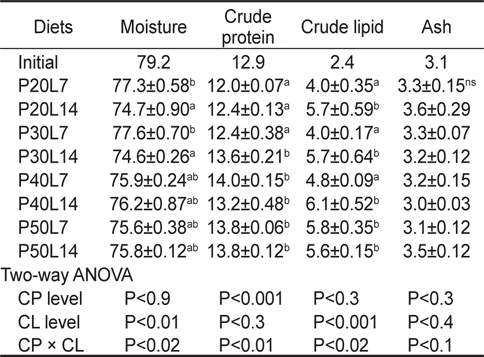
Proximate composition (%) of the whole body in juvenile long snout bullhead Leiocassis longirostris Gunther fed the diets containing different protein (CP) and lipid (CL) levels for 8 weeks1
전어체의 필수아미노산 분석 결과를 Table 5에 나타내었다. 전어체 단백질의 histidine, leucine, lysine 및 pheny lalanine + tyrosine 함량은 사료내 단백질 함량에 영향을 받았으며, 사료 단백질 함량이 증가할수록 이들 아미노산의 함량은 증가하는 경향을 보였고, 다른 아미노산 함량은 사료내 단백질 함량에 영향을 받지 않았다. 또한, 전어체의 모든 필수아미노산은 사료내 지질 함량에는 영향을 받지 않았다. 전어체 지질의 지방산 조성을 Table 6에 나타내었다. 어체 지질 중의 주요 지방산인 C16:0, C18:1n-9, C18:2n-6, C18:3n-3, EPA 및 DHA의 함량은 사료 지질의 지방산 조성과 유사한 경향을 보였다. 어체의 미부동맥에서 채혈한 혈액성상을 Table 7에 나타내었다. Total protein 및 glucose는 사료내 단백질 및 지질 함량에 영향을 받지 않아 실험구간 유의차가 없었다(

Essential amino acids (% in protein) of the whole body in juvenile long snout bullhead Leiocassis longirostris Gunther fed the diets containing different protein (CP) and lipid (CL) levels for 8 weeks1
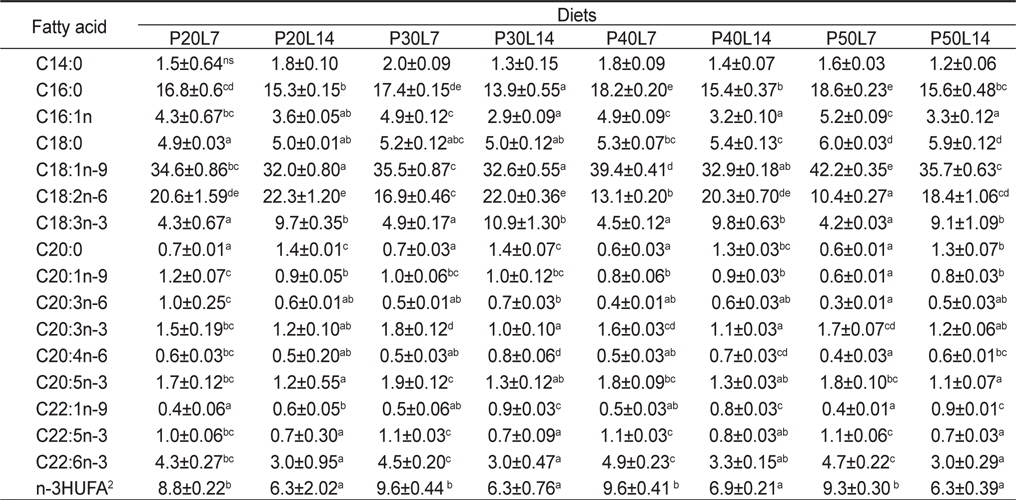
Major fatty acid composition (% of the total fatty acids) of whole body in juvenile long snout bullhead Leiocassis longirostris Gunther fed the diets containing different protein and lipid levels for 10 weeks1
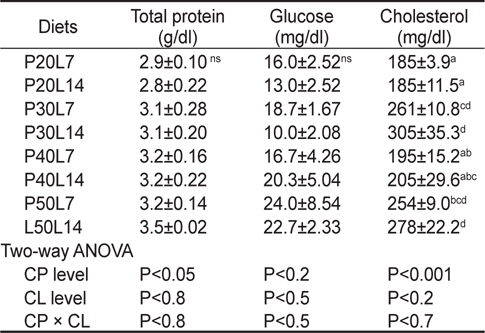
Hematological change of the plasma in juvenile long snout bullhead Leiocassis longirostris Gunther fed the experimental diets containing different protein (CP) and lipid (CL) levels for 8 weeks1
본 연구의 사료 지질 7% 실험구에서, 일간성장율 및 사료효율이 사료 단백질 함량 50%까지 증가한 반면에, 사료 지질 14% 실험구에서는 사료 단백질 함량 30% 이상의 실험구에서 차이가 없는 것으로 나타났다. 이와 같이 사료의 지질 함량에 따라 사료 단백질 함량에 반응하는 어류의 성장과 사료이용효율 차이는 사료 단백질에 대한 비단백질 유래의 에너지 함량에 의한 것으로 판단된다(Company et al., 1999; McGoogan and Gatlin, 1999; Lee et al., 2002). 또한, 단백질 함량 40% 이하인 사료에서는 종어의 성장이나 사료이용효율이 사료의 지질 함량에 영향을 받지 않은 것으로 나타났는데, 이는 종어가 요구하는 사료의 단백질 함량의 충족 여부에 의한 것으로 판단된다. 이러한 결과들로부터, 단백질 함량이 50%인 종어 배합사료에는 지질 함량을 7% 함유시키는 것이 바람직한 것으로 보인다. 이처럼 종어의 단백질 요구량이 50%로 높게 나타나는 것은 종어의 식성이 육식성임을 암시하고 있다. 종어의 단백질 요구량은 담수산인 메기(Khan et al., 1993; Wilson and Moreau, 1996; Ng et al., 2001)보다 높지만, 대부분의 육식성 어류의 단백질 요구량인 45-55% 범위(NRC, 2011)에 속한다.
대부분의 육식성 어류의 경우 사료 지질을 증가시켜 사료의 단백질 함량을 절약할 수 있는 데(De Silva et al., 1991; Vergara et al., 1996; Harpaz et al., 1999; Lee et al., 2002), 본 연구에서는 사료 지질 함량 증가에 따른 사료 단백질 절약 효과가 나타나지 않았다. 이러한 현상은 종어의 경우 사료 지질 이용성이 타 육식성 어류에 비해 낮거나, 사료에 첨가된 지질의 종류가 이 어종의 기호성에 맞지 않았을 수도 있다고 판단된다. 육식성 어류들도 그들의 서식 환경에 따라 지질 이용성이 다른 육식성 어류보다 낮은 경우가 있는데, 예를 들어 넙치나 turbot의 지질 이용성도 타 육식성 어류보다 낮다고 보고되고 있다(Berge and Storebakken 1991; Regost et al. 2001; Lee and Kim, 2005). 또한, 사료의 지질 함량 변화가 어류의 성장에 영향을 미치지 않는다는 보고도 있는데(Nanton et al., 2001), 이는 사료의 단백질, 지질 및 탄수화물 함량에 대한 상호 작용의 차이로 해석된다. 본 연구에서 종어의 최대 성장에 해당하는 사료의 단백질에 대한 에너지 비인 27 g/MJ의 값은 대부분 어류의 적정성장에 필요한 사료의 단백질에 대한 에너지 비(19-27 g/MJ) 범위 내에 있다(NRC, 1993).
사료 단백질 절약의 목적으로 사료내 에너지 함량을 증가시킬 경우, 반드시 고려되어야 할 요소들이 있는데, 예를 들어 사료의 지질 함량이 어체 품질에 미치는 영향에 대한 것들이다. 사료 내 에너지 함량이 높아지면, 여분의 에너지가 체내 지질로 축적되어 어체 품질이 저하되기도 하고, 사료섭취량이 줄어들어 성장이 둔하되기도 한다(Lee and Kim, 2005). 본 연구에서도 어체의 지질 함량은 사료의 에너지 함량에 영향을 받았는데, 사료의 지질 함량이 높은 사료를 섭취한 어류는 지질 함량이 증가하는 경향을 보였다.
어체 지질 중의 지방산 조성도 사료의 지방산 조성에 직접적으로 영향을 받았는데, 사료 지질 함량이 높은 실험구의 어체 EPA와 DHA는 사료 지질 함량이 낮은 실험구보다 낮게 조성되어 있는 반면에 C18:2n-6 및 C18:3n-3 함량은 지질 함량이 높은 사료를 섭취한 어류에서 높았다. 이는 사료에 배합된 지질의 지방산 조성에 영향을 받은 것으로 판단되며, 다른 어종에서도 유사한 경향을 보이고 있다(Bowden et al., 2004; Piedecausa et al., 2007).
본 연구의 결과로 부터, 종어의 경우 사료의 지질 함량 증가는 사료내 단백질 절약 효과를 나타내지 않았으며, 단백질 50%와 지질 7% 함유 사료가 최대 성장과 사료이용효율에 적합할 것으로 전망된다.







